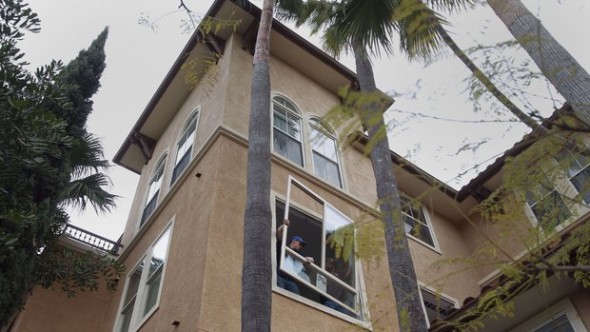More evidence emerged Wednesday that San Diego’s accelerating economy is driving up rents faster than employers are increasing wages, pinching many households.
The San Diego County Apartment Association reported that the average rent in the county was $1,514 a month in its April survey. That’s up 20 percent from the same time last year, although association officials cautioned that its survey does not precisely compare the same set of units each year.
Yet other recent, larger surveys have found even higher average costs, ranging from $1,575 to $1,756 per month — with rents rising at annual rates of between 3 percent and 6 percent — roughly double the 2 percent pace of average wage growth.
Still, the outlook isn’t necessarily dire for the average family. Rent consumes less than half of a typical household’s income, and San Diego’s overall inflation rate was low at 1.3 percent in the second half of last year. So rents would have to keep rising faster than wages for years to cut into disposable income.
On the other hand, builders haven’t kept up with demand for more than decade.
“There’s no question rents are on the rise because of the housing shortage,” said Alan Nevin, an apartment industry analyst at Xpera. “The middle class really gets crunched.”
Over the last year, employers in San Diego County have added nearly 41,000 jobs, with the biggest growth coming in higher-paying fields such as biotech, engineering and other professional services. That’s drawn more people to the region who can afford to pay for the newer units coming online, the majority of which are filled with amenities and charge more than $2,000 a month for studio apartments. Additionally, the improved economy has handed more millennials the resources to move out of their parents’ homes, adding to the demand for housing.
It’s all led to a squeeze on current renters, who haven’t seen their paychecks increase as briskly.
“Living in San Diego you expect the rents to be somewhat high. In recent years though, the rents seem to be escalating at an abnormally fast rate,” said 34-year-old Alex Rock, who lives in the UTC area and has seen his rent rise by $445 since 2012. “My girlfriend and I have already done small things to cut down the cost of living, like cutting cable … but we will be relocating this fall without a doubt.”
Rock may not find much out there.
Nevin said developers should be adding 13,000 to 15,000 new housing units per year to satisfy the demand. They’re not even close: In 2014, there were 6,874 new residential units approved in the county, according to the Census.
Still, the county’s vacancy rate, or the number of units available, rose to 4.1 percent, up from 2.7 percent last year, as military deployments increased and some new buildings opened, the association reported. The rate was close to its long-term average of about 5 percent in the county, which had 424,548 multifamily units.
Experts note that the association’s survey is dominated by smaller landlords.
Russ Valone, president of Marketpointe Realty Advisors, said the new, high-end units that opened recently have given owners of smaller, older units an opportunity to raise their rents and still undercut the competition. Based on his own, larger survey, Valone estimated in March that the average rent rose 4.5 percent over the year to $1,575 per month.
He said that if rents keep outpacing wage growth long enough, vacancy rates would begin to creep higher.
“You would start to see people having to respond to the increase in rents the way they responded to a softening economic condition, with doubling up, boomeranging, especially in that 18 to 25 age category moving back home to their parents,” he said.
Rising rents can also push more people into the home-buying market, where prices rose about 4.6 percent over the last year.
For the median-priced home of $455,000, the mortgage payment would be $2,230 a month, including taxes and insurance, according to Mark Goldman, a loan officer at C2 Financial. That assumes a 30-year, fixed-rate loan at Wednesday’s average interest rate of about 4.2 percent.
For Dave Stiff, buying was the solution to avoiding a 4 percent hike in his rent for a downtown one-bedroom apartment he shares with his fiance, Adam. Stiff was paying $2,185 a month for the unit in the East Village, but later this year the couple will move to a 3-bedroom townhome in Mission Valley’s Civita, where the monthly payment is only slightly higher.
“Renting downtown has been fun but expensive. We’re paying the same amount for a small, one-bedroom as a two-bedroom townhouse in Hillcrest a few years ago,” he said. “For just a little more per month, we’ll be moving into a bigger place that is all our own and finally stop throwing away money on rent.”
Others who can’t afford to buy have fewer alternatives. The commercial real-estate firm CBRE reported in April that the average rent in San Diego County was $1,756 per month.
It projects the rent to increase by more than 3 percent in each of the next three years, until slowing to 2.4 percent annually in 2020. At that time, CBRE projects the average rent to be $2,040 per month.
Alan Pentico, the president of the apartment association, said its survey is sent to association members and some larger developments. He noted that about 65 percent of the landlords in the region are independent, defined as owning 50 or fewer units. The questionnaire goes out to about 6,000 property owners in the county, representing 18,314 rental units.
This article was originally published in the San Diego Union Tribune and can be found HERE.



